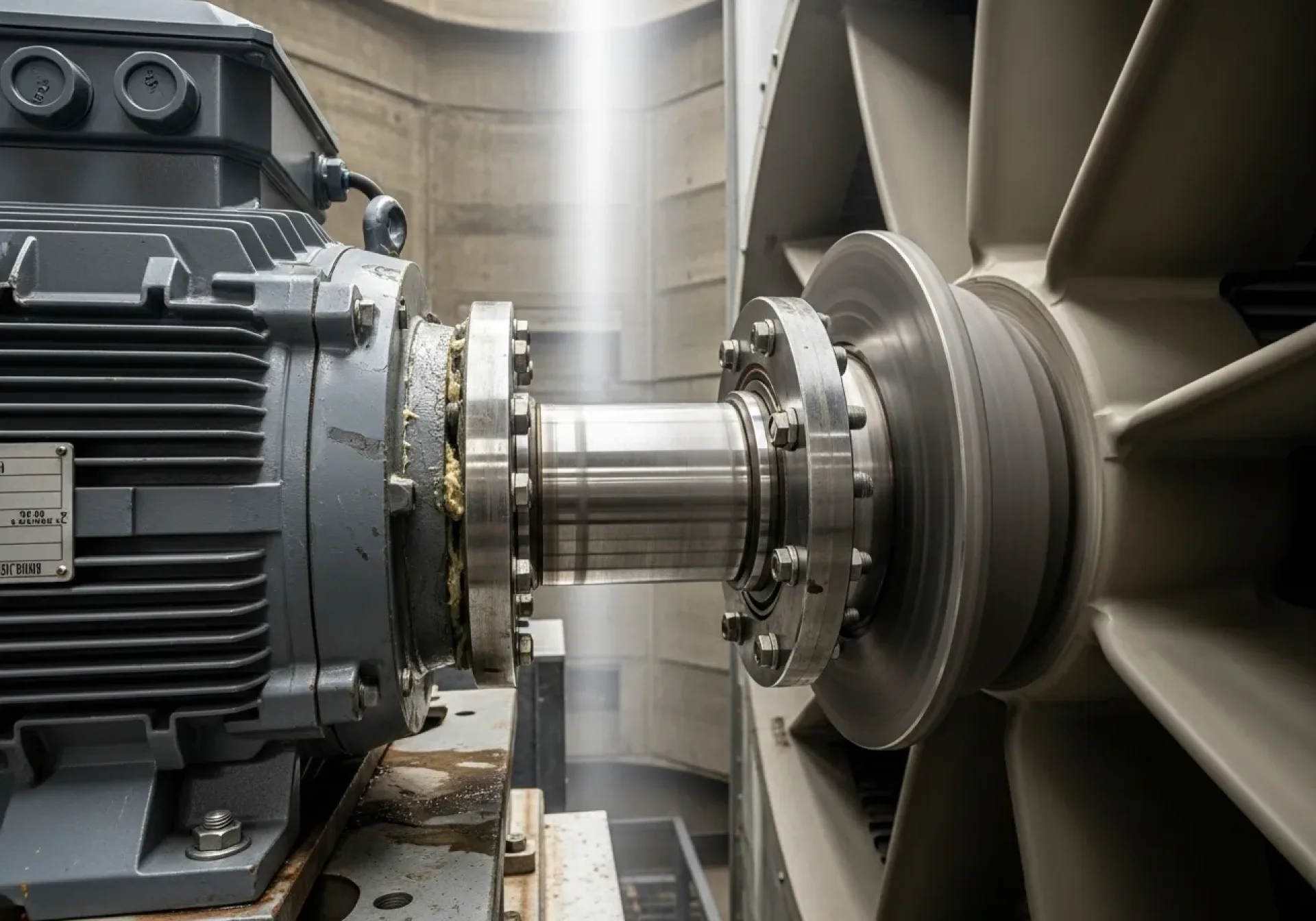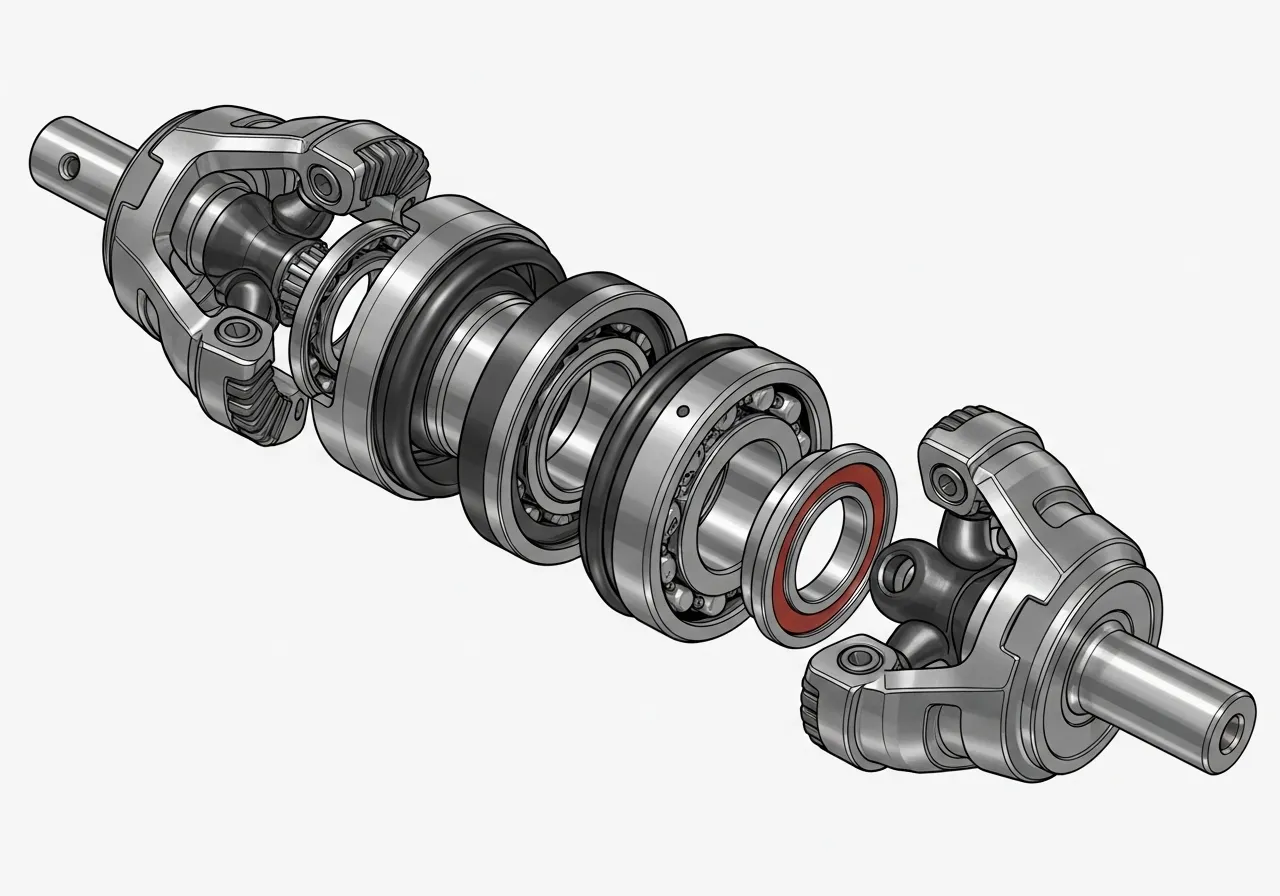What is a Drive Shaft? Function, Failure Symptoms, and Pro-Level Maintenance (For Cooling Tower Systems)

In a gear-driven Cooling Tower, the motor is typically installed on a platform above the deck, transmitting power via a drive shaft to a right-angle gearbox connected to the fan shaft. The shaft's duty isn't just "transmitting torque"; it must cope with vibration, humidity, water droplets (drift), and chemicals from the water treatment system, all of which directly impact wear and safety.
Unlike an automotive shaft operating in drier, more stable temperatures, a cooling tower shaft exists in a moist, corrosive atmosphere with risks of chemical spray. Therefore, special emphasis is placed on corrosion protection, shaft weight (affecting inertia/bearing loads), sealing, and guarding.
Structure and Operating Principle
A standard drive setup includes an electric motor (often horizontal), a flexible coupling on the motor side, the shaft itself (single or multi-piece), spacers/flanges, and a coupling on the gearbox side. Some models use a "floating shaft" that relies on flexible couplings at both ends to compensate for angular/parallel misalignment and absorb start-stop shock loads.
The shaft must be dynamically balanced to an appropriate grade (e.g., ISO 21940-11, formerly ISO 1940, Grade G6.3 or better for high speeds) and have a sufficient critical speed margin to avoid resonance within the operating speed range. Proper installation establishes correct horizontal and vertical alignment, compensating for the thermal growth of the motor/gearbox base after continuous operation.
Select Shaft and Coupling Materials "Fit for the Job"
The shaft material affects durability, vibration, and the load transmitted to the gear/motor bearings. Many plants switch from carbon steel to FRP (Fiber-Reinforced Polymer) or stainless steel, depending on chemical exposure and spin weight limitations.
Comparison of Popular Options
- Carbon Steel: Strong and affordable, but heavy and rust-prone. Requires high-quality anti-corrosion coating/painting.
- Stainless Steel (e.g., 304/316): Better corrosion resistance, but heavier than composites and has a higher cost.
- FRP/Composite: Lightweight, excellent corrosion resistance, reduces inertia and bearing loads, ideal for high-moisture conditions. Requires quality assembly and adherence to manufacturer's torque specs.
- Flexible Couplings (elastomeric/disc/grid): Help compensate for misalignment and reduce shock. Select based on temperature/chemicals/torque.
- Hardware/Bolts: Should be of appropriate grade with anti-seize/locking compounds, especially where exposed to continuous water spray.
Alignment, Balance, and Critical Speed: The Three Pillars of Stability
Alignment is the starting point. Just a few millimeters of misalignment on a long shaft can induce severe vibration and stress on couplings and bearings. As residual heat causes bases to expand slightly (thermal growth), alignment should ideally be set for the actual running condition (hot alignment). Soft foot issues must be corrected before final bolt-down.
Balancing to standard reduces centrifugal force and cumulative vibration. In practice, check the balance certificate from the manufacturer and re-balance after major repairs or component changes, especially for multi-piece shafts with long spacers.
Critical speed (Ncr) is the speed at which the shaft is prone to violent vibration due to resonance. A simple rule is to keep the operating speed sufficiently far from Ncr (e.g., 20-25% away) for safety and component life. Calculating Ncr involves the stiffness of the shaft/bearings, span length, and the rotating mass at the ends. Increasing length without increasing strength, or adding accessories, can inadvertently shift Ncr closer to the operating range.
Common Failure Symptoms in Cooling Towers
Early symptoms often start with an unusual hum or whine and increased vibration at a specific speed, followed by cracked coupling elastomers or loose flange bolts. If unchecked, it can escalate to a bent/twisted shaft or premature gearbox bearing wear. The hidden culprits are often minor misalignment left uncorrected, improper bolt torque, imbalance from rust/buildup on the shaft, or failing to account for thermal growth during alignment.
The environment also plays a role. Water drift carrying treatment chemicals can accelerate corrosion on flanges and bolts, especially where coatings have failed. A proper shaft guard that allows ventilation but blocks spray and foreign objects helps reduce buildup that causes imbalance.
Preventive Maintenance Steps to Maintain as a Discipline
Good maintenance starts with a clear inspection schedule: weekly visual checks, monthly vibration measurements, quarterly alignment and bolt torque checks, or after major repairs. Data logging is crucial to "see failure coming" (trend analysis) rather than waiting for a shutdown.
Measuring vibration in radial/axial directions at the bearings near both couplings helps specify the fault type (imbalance, misalignment, looseness, phase shift). Thermography can spot hot spots on couplings/flanges, indicating abnormal friction. Replacing coupling elastomers based on run-hours rather than waiting for failure significantly reduces sudden downtime.
Quick Troubleshooting Guide: SymptomCauseAction
Troubleshooting Quick Guide
- Vibration at a specific speed Imbalance / Approaching Ncr Clean buildup/scale, re-balance, check critical speed margin.
- Continuous humming noise Misalignment / Loose bolts Perform laser alignment, check soft foot, torque bolts to spec.
- Elastomers crack quickly Wrong material spec / High temp / Chemical attack Change coupling type, improve ventilation/guarding, check misalignment.
- Heavy rust on flange/bolts Inadequate corrosion protection Change material/plating, apply epoxy paint, use appropriate thread locker.
- Gearbox bearing hot/wears fast Excessive vibration transfer from shaft/coupling Check alignment/balance, review shaft weight and bearing load.
Safety: No Exceptions
A high-speed rotating shaft in a wet, slippery environment is a direct hazard. A sturdy shaft guard, clear warning signs, and Lock-Out/Tag-Out (LOTO) procedures are mandatory before any work. Hot work or height permits (if applicable) should be part of the SOP. Furthermore, ensuring safe footing, tool fall-protection, and emergency drills are vital parts of a continuous safety culture.
New Installation or Retrofit: Pre-Startup Checklist
When changing from steel to FRP/composite or switching coupling types, re-verify the system's startup/max torque, spacer length, and the new critical speed margin. Flange/bolt patterns must match the gear/motor manufacturer. If the base was modified, ensure proper grouting to minimize soft foot on uneven foundations. The initial run-in period should include logging vibration and temperature every 15-30 minutes to confirm stability before continuous operation.
A Small Shaft Managing a Large Risk
The drive shaft in a cooling tower is a "small" component relative to the whole tower, but its impact on safety, energy, and system availability is "larger than you think." Selecting materials and couplings suited for corrosion, precise alignment and balancing, maintaining a safe critical speed margin, and disciplined maintenance are the four pillars that keep the fan running smoothly, cooling efficiently, and operating safely for the long term. When the operations team can read the sounds and vibrations, review trends regularly, and utilize LOTO every time, this single shaft will keep the entire system running steadyand help the cooling tower do its job at peak efficiency.



